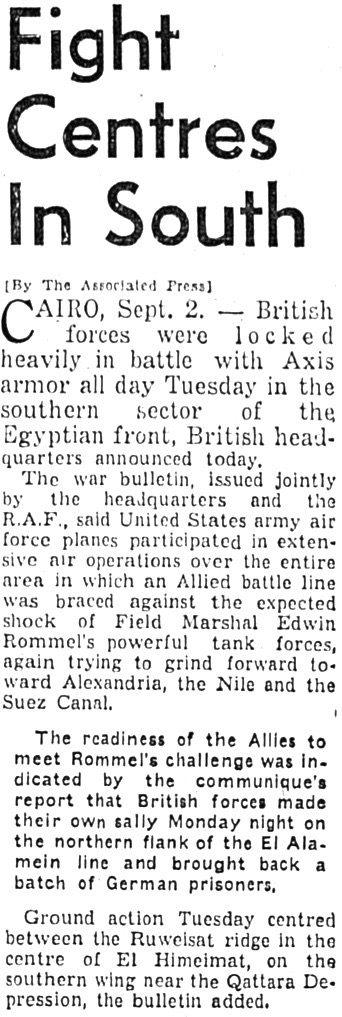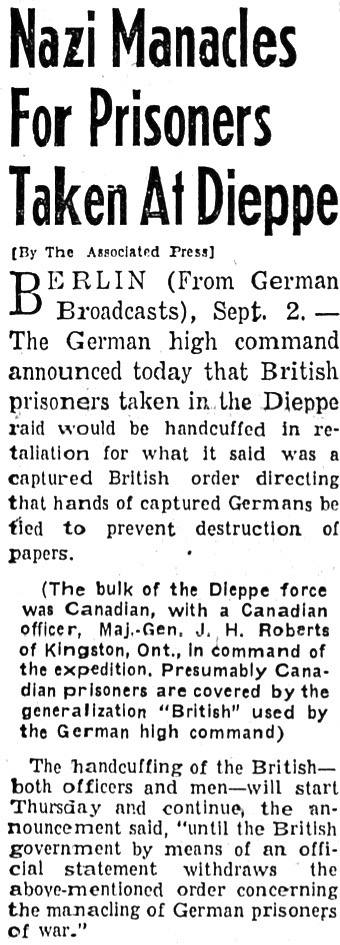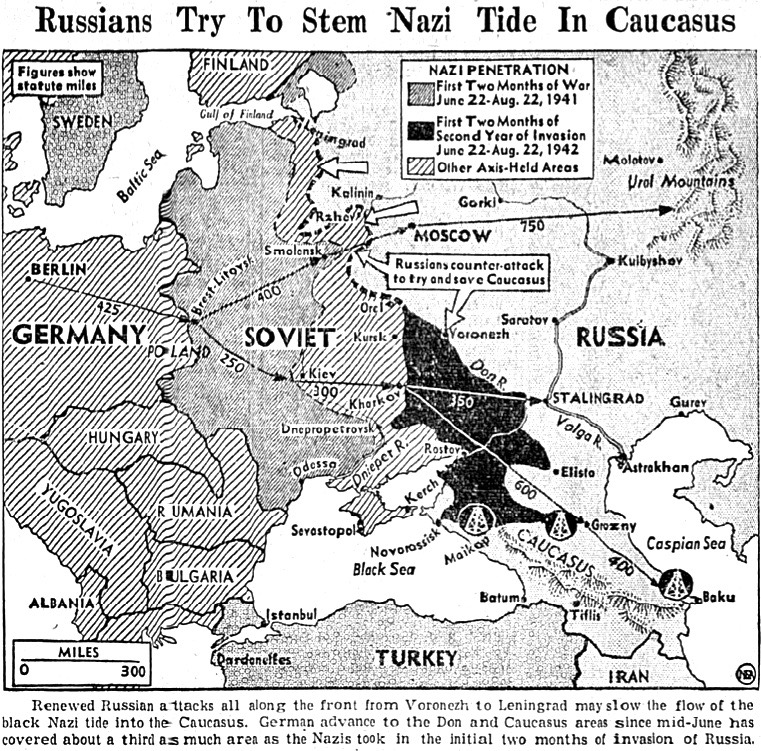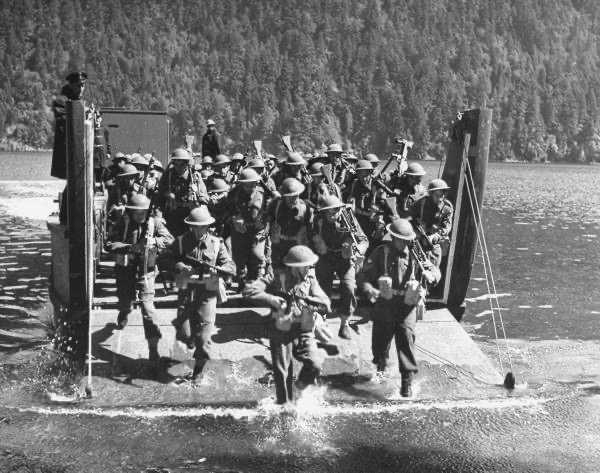News Clippings Related to the Dieppe Raid Still Appear
And the Positives Are Still Mixed with the Negatives
After three years of war, German forces are facing more than a few setbacks
Cartoon by Mozel. Found in The Winnipeg Tribune, Sept. 2, 1942, page 6
Introduction:
The first two-thirds of the book Combined Operations: The Official Story of the Commandos by Hilary St. George Saunders (also author of The Green Beret) provides detailed descriptions of the raids in which Commando units were involved, including the raid on Rommel in North Africa, Vaagso in Norway, Bruneval and St. Nazaire in France, and Diego Suarez on Madagascar, and more. The last third deals with Dieppe.
St. George Saunders entitles the first chapter about Dieppe "Reconnaissance in Force" and begins as follows:
St. George Saunders entitles the first chapter about Dieppe "Reconnaissance in Force" and begins as follows:
The raid on Bruneval had been small, short and sharp: its success had been complete. The raid on St. Nazaire had been larger, longer and sharper; its success, measured in terms of the Battle of the Atlantic, also complete. It was time to plan the next stage.
Combined Operations: The Official Story... tells a good deal about the planning of the raid, its overall goals, and the results of the raid at the various places along the French coast where men and tanks (mostly Canadians), etc., were put ashore. News clippings after the fact from The Winnipeg Tribune provide a few more details, thus my online research and numerous entries here.
I recommend St. George Saunders' book to readers as it provides a good deal of history related to the Combined Operations organization, the importance of 'combined operations' as a strategy and the significance of the Dieppe Raid. For example, the excerpt from The Official Story... continues:
In the spring of 1942, the demands of other and distant theatres of war still prevented the concentration in England of a United Nations force large enough and sufficiently well trained and equipped to launch a full-scale invasion of German-occupied Europe...
...What could be done was to raid Europe in force. To mount a raid on a much larger scale than that which had been carried out on St. Nazaire would not only harass the enemy, which is, it cannot to too often repeated, the primary object of raiding; it would also be a means of providing the Allied General Staffs with very important and, indeed, essential information concerning his defences in the West.
His strength must be tested, his methods examined at the point of the bayonet and the Bren gun, if the military problem which the forces of the United Nations will have to meet, should it be decided to launch an army of invasion across the narrow seas, is to be solved.
The task was hazardous, but then so is any operation of war, and the end was imperative. (Page 110)
Photo from Combined Operations: The Official Story of the Commandos
British Official Photos - Crown Copyright
British and United States forces would be involved in the invasion of North Africa, Operation TORCH, about two months after the above article was shared. Members of the first draft of Canadians in Combined Operations (from the RCNVR) were placed into service aboard Allied landing craft and delivered both U.K. and U.S. troops to various beaches near Oran and Algiers.
My father (left) "Doug" Harrison and mate Buryl "Mac" McIntyre trained in
Halifax in 1941 and (with most in their division) volunteered for Comb. Ops
One soldier gets kicked out of a landing craft and another gets picked up by a limousine...
The Nazis might crack a defense line in Stalingrad but in the end their own back will be cracked:
Have you heard the term "Cologned" before? Here goes...
Canadian forces, during WWII, made a mark on land, on the sea and in the air:
There is a newsreel out there that will reveal video re "Allied Commandos Raid France." Link to "University of South Carolina" and join the hunt:
Had enough of the heat and humidity in this 'sweaty summer of 2022? Here's what you can get for 60 cents including tax, and they'll return you to point of departure!!
A near miss!
My father had a very significant near miss as well. He missed the Dieppe raid by one day because of a scheduled leave. He knew something big was happening while on leave so he returned early, and was sent to clean up the returning (badly damaged, blood covered) landing crafts. I don't think he ever got over the "survival guilt."
My father (RCNVR, Combined Ops) wrote "survival guilt" under his officer's letter
as found in St. Nazaire to Singapore, Volume 1, pg. 66 (The other notes are mine)
And 'yes,' I do know where Lloyd Campbell is buried now. Near Berlin.
Also found in St. Nazaire to Singapore, Volume 1. My father, front center,
is wearing my Beatles cap from the 1960s. I'd like to have that now! GH
I am not sure if Canadian officers were handcuffed. Below is a pencil sketch of Lt. Robert McRae, mentioned a few items above, while he was POW - and masterful piano player - after the Dieppe raid:
As found in St. Nazaire to Singapore: The Canadian Amphibious War
Volume 1. The skilled artist is unknown at this time, 2022
The previous article continues:
Spareribs at 18 cents per pound caught my eye:
England and Canada's 'productive capacity' grew by leaps and bounds during WWII. But no other country out-produced the American military industry:
Also from the Editorial page. It could be said that The Canadian Press out-produced all other Canadian news bureaus, perhaps thanks to Canadian war correspondent Ross Munro:
Ross Munro, mentioned above, would return to Europe and post many stories from the war in the Mediterranean, i.e., from Sicily and Italy:
Canadian war correspondents, videographers and film producers in Italy, 1943.
Click below to learn more about their work in the Mediterranean.
Here's news of a Commando movie with a strong Canadian connection...
Much filming for the movie was done in British Columbia, Canada
Not a good poster. Click here for better resolution photos and video!
The movie hit theatres as "Commandos Strike at Dawn" starring Paul Muni and Lillian Gish and "a flock of extras". I have come across a few photos that relate to the movie; the first one was used in the above movie poster:
Note the date stamp in lower right hand corner; same as the Dieppe raid
Where on the Vancouver Island? Help Wanted!
And now, back to the real world news from The Winnipeg Tribune:
Please click here to view Research: Post-Dieppe, Sept. 1 - 7 (Part 1)
Unattributed Photos GH




































No comments:
Post a Comment